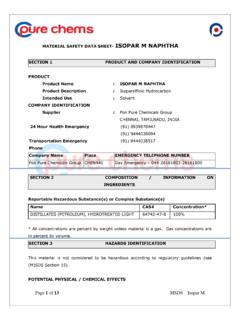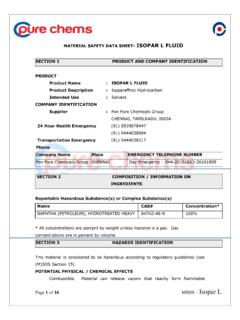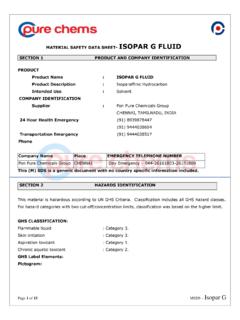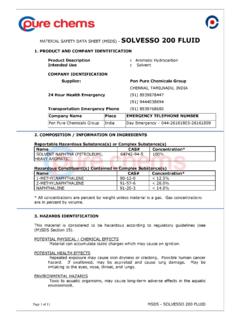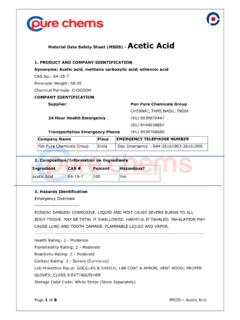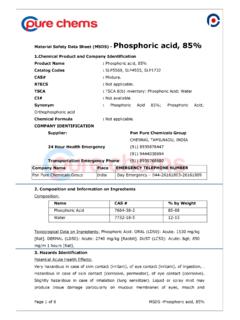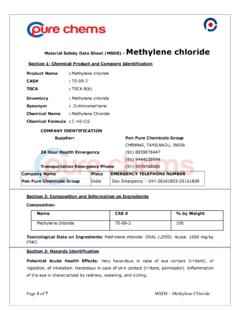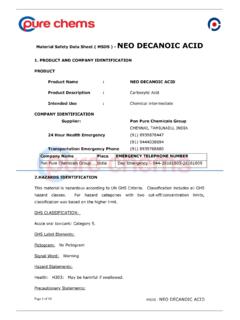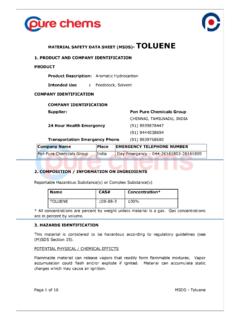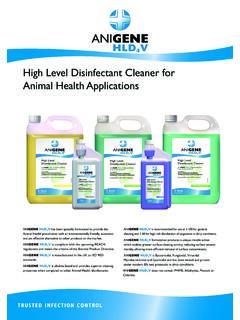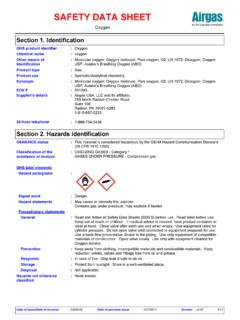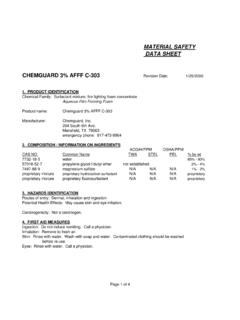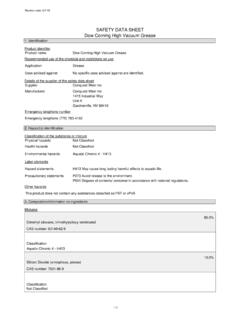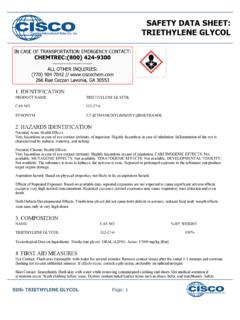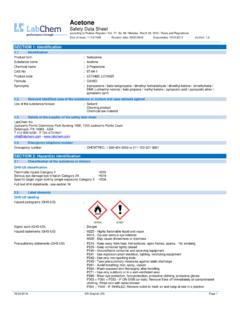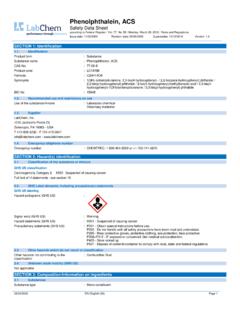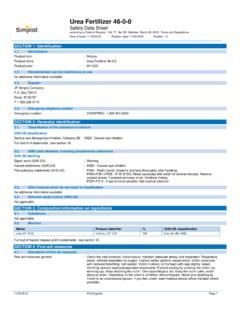Transcription of Material Safety data sheet (MSDS) Tetrahydrofuran
1 Page 1 of 12 msds : THF Material Safety data sheet ( msds ) - Tetrahydrofuran 1. Substance/preparation and company identification Material : Tetrahydrofuran Use: Chemical used in synthesis and/or formulation of industrial products COMPANY IDENTIFICATION Supplier: Pon Pure Chemicals Group CHENNAI, TAMILNADU, INDIA 24 Hour Health Emergency (91) 8939878447 (91) 9444038694 Transportation Emergency Phone (91) 8939768680 Company Name Place EMERGENCY TELEPHONE NUMBER Pon Pure Chemicals Group India Day Emergency 044-26161803-26161809 2. Composition/information on ingredients Chemical nature Tetrahydrofuran CAS Number: 109-99-9 EC-Number: 203-726-8 INDEX- Hazardous ingredients Tetrahydrofuran Content (W/W): 99 % - 100 % CAS Number: 109-99-9 EC-Number: 203-726-8 INDEX-Number: 603- 025-00-0 Hazard symbol(s): F, Xn R-phrase(s): 11, 19, 40, 36/37, 22, 67 The wording of the hazard symbols and R-phrases is specified in section 16 if dangerous ingredients are mentioned.
2 3. Hazard identification Highly flammable. May form explosive peroxides. Irritating to eyes and respiratory system. Harmful if swallowed. Page 2 of 12 msds : THF Limited evidence of a carcinogenic effect. Vapours may cause drowsiness and dizziness. 4. First-Aid Measures general advice: Immediately remove contaminated clothing. If danger of loss of consciousness, place patient in recovery position and transport accordingly. Apply artificial respiration if necessary. First aid personnel should pay attention to their own Safety . If inhaled: Keep patient calm, remove to fresh air, seek medical attention. On skin contact: Wash thoroughly with soap and water. On contact with eyes: Immediately wash affected eyes for at least 15 minutes under running water with eyelids held open, consult an eye specialist.
3 On ingestion: Rinse mouth and then drink plenty of water. Note to physician: Symptoms: The most important known symptoms and effects are described in the labelling (see section 2) and/or in section 11., Further symptoms are possible Treatment: Treat according to symptoms (decontamination, vital functions), no known specific antidote. 5. Fire-Fighting Measures Suitable extinguishing media: Water spray, dry powder, foam, carbon dioxide Specific hazards: Carbon oxides, nitrogen oxides. The substances/groups of substances mentioned can be released in case of fire. Special protective equipment: Wear self-contained breathing apparatus and chemical-protective clothing. Further information: Collect contaminated extinguishing water separately, do not allow to reach sewage or effluent systems.
4 Page 3 of 12 msds : THF 6. Accidental Release Measures Personal precautions: Breathing protection required. Vapours are heavy and collect in low areas. Environmental precautions: Do not empty into drains. Methods for cleaning up or taking up: For large amounts: Pump off product. For residues: Pick up with suitable absorbent Material ( sand, sawdust, general -purpose binder, kieselguhr). Dispose of absorbed Material in accordance with regulations. 7. Handling and Storage Handling Prevent contact with air/oxygen (formation of peroxide). Handle under dry inert gas. Ensure thorough ventilation of stores and work areas. Handle in accordance with good industrial hygiene and Safety practice. Remove contaminated clothing and protective equipment before entering eating areas.
5 Hands and/or face should be washed before breaks and at the end of the shift. When using do not eat, drink or smoke. Protection against fire and explosion: Prevent electrostatic charge - sources of ignition should be kept well clear - fire extinguishers should be kept handy. Storage Further information on storage conditions: Keep container tightly closed. Keep under nitrogen. Storage stability: Storage duration: 12 Months The product is stabilized, the shelf life should be noted. From the data on storage duration in this Safety data sheet no agreed statement regarding the warrantee of application properties can be deduced. Additives: 2,6-di-tert-butyl-p-cresol (CAS Number: 128-37-0) 8. Exposure controls and personal protection Components with occupational exposure limits Page 4 of 12 msds : THF Tetrahydrofuran , 109-99-9; TWA value 50 ppm (ACGIHTLV) STEL value 100 ppm (ACGIHTLV) Skin Designation (ACGIHTLV) The substance can be absorbed through the skin.
6 Personal protective equipment Respiratory protection: Respiratory protection in case of vapour/aerosol release. Gas filter for gases/vapours of organic compounds (boiling point >65 C, e. g. EN 14387 Type A) Hand protection: Chemical resistant protective gloves (EN 374) Suitable materials also with prolonged, direct contact (Recommended: Protective index 6, corresponding > 480 minutes of permeation time according to EN 374): Polyethylene-Laminate (PE laminate) - ca. mm coating thickness Supplementary note: The specifications are based on tests, literature data and information of glove manufacturers or are derived from similar substances by analogy. Due to many conditions ( temperature) it must be considered, that the practical usage of a chemical-protective glove in practice may be much shorter than the permeation time determined through testing.
7 Eye protection: Tightly fitting Safety goggles (cage goggles) ( EN 166) and face shield. general Safety and hygiene measures: Handle in accordance with good industrial hygiene and Safety practice. Wearing of closed work clothing is required additionally to the stated personal protection equipment. Avoid contact with the skin, eyes and clothing. Do not inhale gases/vapours/aerosols. When using, do not eat, drink or smoke. Hands and/or face should be washed before breaks and at the end of the shift. Gloves must be inspected regularly and prior to each use. Replace if necessary ( pinhole leaks). Take off immediately all contaminated clothing. Wash contaminated clothing before reuse. Page 5 of 12 msds : THF 9. Physical and Chemical Properties Form: Liquid Colour: Colourless Odour: of acetone Melting point: C Boiling point: - C Flash point: -22 C Flammability: Highly flammable.
8 Lower explosion limit: %(V) (air) ( C) Upper Explosive Limit : For liquids not relevant for classification and labelling. Ignition temperature: 230 C(DIN 51794) Self ignition: Based on its structural properties the product is not classified as self- igniting. Self heating ability: It is not a substance capable of spontaneous heating. Explosion hazard: Based on the chemical structure there is no indicating of explosive properties. Fire promoting properties: not fire-propagating Vapour pressure: 173 mbar(20 C) 586 mbar(50 C) Density: g/cm3( C) g/cm3(15 C) (15 C) g/cm3(50 C) Relative density: (20 C) No data available. Bulk density: Solubility in water: miscible, Literature data . (25 C) Solubility (qualitative) solvent(s): organic solvents miscible Partitioning coefficient n-octanol/water (log Pow): (25 C) Page 6 of 12 msds : THF Surface tension: Based on chemical structure, surface activity is not to be expected.
9 Viscosity, dynamic: Literature data . (50 C) Literature data . Molar mass: g/mol 10. Stability and Reactivity Conditions to avoid: Avoid all sources of ignition: heat, sparks, open flame. Avoid electro-static charge. Thermal decomposition: 110 C, 20 kJ/kg It is not a self-decompositionable substance. Thermal decomposition: 400 C No exothermic decomposition within the mentioned temperature range. Substances to avoid: Strong oxidizing agents Corrosion to metals: No corrosive effect on metal. Hazardous reactions: Evolution of peroxides. No hazardous decomposition products if stored and handled as prescribed/indicated. 11. Toxicological Information Acute toxicity Assessment of acute toxicity: Of moderate toxicity after single ingestion.
10 Virtually nontoxic by inhalation. Virtually nontoxic after a single skin contact. High concentrations in the air may cause narcosis. The substance can be absorbed through the skin. LD50 rat (oral): 1,650 mg/kg LC50 rat (by inhalation): > mg/l 6 h The vapour was tested. LD50 rat (dermal): > 2,000 mg/kg (OECD Guideline 402) Irritation Assessment of irritating effects: Not irritating to the skin. May cause severe damage to the eyes. Causes temporary irritation of the respiratory tract. Primary skin irritation rabbit: non-irritant (Draize test) Primary irritations of the mucous membrane rabbit: Risk of serious damage to eyes. Page 7 of 12 msds : THF (Draize test) Assessment other acute effects Causes temporary irritation of the respiratory tract. Possible narcotic effects (drowsiness or dizziness).
